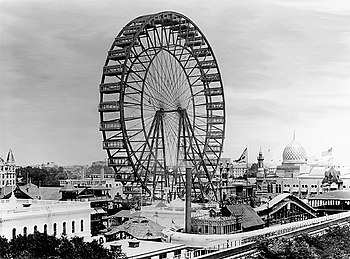The World's Columbian Exhibition
By Barbara Schock
The fair was meant to show the rest of the country
and the world that Chicago had survived the fire
of 1871 and had become a center of commercial and
artistic activity.
Many communities in the Midwest provided exhibits
and expertise for the displays and events at the
fair. Seven hundred Galesburg public school
children created examples of their school work.
These were bound into volumes which were sent to
the fair for showing when it opened on May 1st.
The April 4, 1893, Republican-Register reported
the work of the students was on display at the
high school on South Broad Street. The second
floor hallway was filled with eight tables on
which the works of each grade were displayed.
Photographs of the members of each class were
included.
The work covered the subjects of geography,
zoology, natural philosophy, drawing, penmanship
and manual training. An array of pieces of
furniture were also in the exhibit. The newspaper
mentioned a dresser by Edwin Scott, a hall rack by
Ralph Roodstrum, a writing desk by Charles
Redebaugh and a table by John Bridge. All the
pieces of furniture were made of oak and heavily
carved.
D.V. Purington, president of the Purington Paving
Brick Company of Galesburg, had proposed an
exhibit of the different styles of brick paving at
the Columbian Exposition. The Republican-Register
said “This is a matter in which our citizens can
well afford to take a personal interest. The
splendid brick factories are advertising Galesburg
as nothing else is. It is hoped that the plan will
be perfected at an early date, that the whole
world may have an opportunity to see in useful
combinations, from raw to perfected materials, the
products of our brick yards.”
There were many “firsts” at the fair, including
the huge Ferris Wheel, invented by George
Washington Gale Ferris, a descendant of one of
Galesburg’s founders; the “Pledge of Allegiance”
to the United States flag; shredded wheat
breakfast cereal and Cracker Jack popcorn.
Carl Sandburg and his family knew only that which
they read in the newspapers about the World’s
Fair. They were not among the 27.5 million people
who entered the grounds and responded with awe and
enthusiasm. Henry Ward, a barbershop porter like
Sandburg, did go to the fair for three days. When
he arrived back in Galesburg, he told the other
boys about his experiences. The boys listened to
Henry and asked him questions for two hours.
Afterward, they felt as if they had experienced
the fair as well. They were reassured that there
was an actual fair up in Chicago.
|
|
|
| Date | Title |
| June 17, 2013 | The World's Columbian Exhibition |
| June 10, 2013 | Fruit Short-Cake |
| June 3, 2013 | Horatio Alger, Author |
| May 27, 2013 | Memorial Day, 1887 |
| May 20, 2013 | Professor Jon W. Grubb |
| May 13, 2013 | Beginnings of Lombard University |
| May 6, 2013 | Young Sandburg’s View of Lombard College |
| April 29, 2013 | Thinking |
| April 22, 2013 | Robert Colville, Master Mechanic |
| April 15, 2013 | The Galesburg Opera House |
| April 8, 2013 | Grocery Stores and Sample Rooms |
| April 1, 2013 | A Hearty Breakfast |
| March 25, 2013 | The Lost Wallpaper Legend |
| March 18, 2013 | Martin G. Sandburg |
| March 4, 2013 | The Edison Talking Machine |
| February 25, 2013 | Joe Elser, Civil War Veteran |
| February 18, 2013 | Remember the Maine... |
| February 11, 2013 | Lincoln's Birthday |
| February 4, 2013 | Curiosity |
Sandburg's Hometown (GalesburgPlanet.com)
Earlier articles by Barbara Schock published on GalesburgPlanet.com
-----
www.sandburg.org
